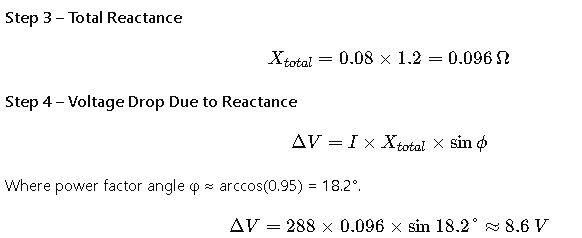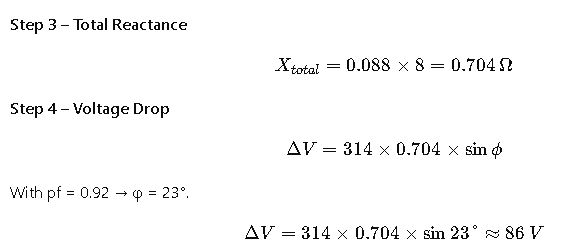Electrical engineers, designers, and consultants rely on cable reactance calculations to guarantee efficient, safe operations. IEC and IEEE standards provide reliable methodologies for calculating reactance, essential in distribution, industrial, and renewable applications.
Cable Reactance Calculator — IEC / IEEE
Inductance & inductive reactance (Ω/m and Ω/km) — quick engineering estimates.
What formulas are used?
- Inductance (approx. single-core):
L ≈ 2×10-7 · ln(D / r)(H/m), where D = centre-to-centre distance (m) and r = conductor radius (m). - Inductive reactance:
XL = 2·π·f·L(Ω per metre). Multiply by 1000 to get Ω/km. - Notes: For full IEC-compliant cable impedance use IEC 60287; this tool provides quick planning estimates.
Assumptions & limitations
Understanding Cable Reactance in Power Systems
Cable reactance represents the inductive opposition that conductors introduce to alternating current (AC). Unlike resistance (which dissipates power as heat), reactance affects voltage drop, short-circuit currents, and system stability.
Key factors influencing reactance include:
- Conductor geometry (spacing, diameter, arrangement).
- Installation type (buried, in ducts, aerial).
- Frequency of operation (usually 50 Hz IEC or 60 Hz IEEE).
- Presence of screens, armoring, or proximity effects.
Accurate reactance estimation ensures:
- Proper voltage drop design.
- Reliable short-circuit withstand analysis.
- Compliance with IEC 60287, IEC 60909, and IEEE 141/399/242 standards.
Common Cable Reactance Values – IEC and IEEE
Below is a technical reference table showing common reactance values (X in Ω/km) for standard low-voltage and medium-voltage cables at 50 Hz and 60 Hz. Values are typical and compiled from IEC and IEEE references, manufacturer catalogs, and field experience.
Note: Exact values depend on cable manufacturer, layout, and installation. Use calculators or manufacturer datasheets for precise design.
Table 1: Typical Reactance of Copper Cables (IEC/IEEE Reference)
| Conductor Cross-Section (mm²) | Reactance at 50 Hz (Ω/km) | Reactance at 60 Hz (Ω/km) | Typical Applications |
|---|---|---|---|
| 16 mm² | 0.110 – 0.115 | 0.130 – 0.138 | Small feeders, control circuits |
| 25 mm² | 0.100 – 0.105 | 0.120 – 0.126 | Distribution branches |
| 35 mm² | 0.095 – 0.100 | 0.114 – 0.121 | Motors up to 30 kW |
| 50 mm² | 0.090 – 0.095 | 0.108 – 0.114 | Medium feeders |
| 70 mm² | 0.085 – 0.090 | 0.102 – 0.108 | Small substations |
| 95 mm² | 0.080 – 0.085 | 0.096 – 0.102 | Transformer connections |
| 120 mm² | 0.078 – 0.082 | 0.093 – 0.098 | Large motors |
| 150 mm² | 0.075 – 0.080 | 0.090 – 0.095 | Industrial bus feeders |
| 185 mm² | 0.073 – 0.078 | 0.088 – 0.092 | MV feeders |
| 240 mm² | 0.070 – 0.075 | 0.084 – 0.090 | High load distribution |
| 300 mm² | 0.068 – 0.073 | 0.081 – 0.086 | Generator connections |
| 400 mm² | 0.065 – 0.070 | 0.078 – 0.082 | Industrial main feeders |
| 500 mm² | 0.063 – 0.068 | 0.075 – 0.080 | Large substations |
| 630 mm² | 0.060 – 0.065 | 0.072 – 0.077 | Transmission feeders |
| 800 mm² | 0.058 – 0.063 | 0.070 – 0.075 | HV underground feeders |
| 1000 mm² | 0.055 – 0.060 | 0.066 – 0.072 | Power plants export cables |
Table 2: Typical Reactance of Aluminum Cables (IEC/IEEE Reference)
| Conductor Cross-Section (mm²) | Reactance at 50 Hz (Ω/km) | Reactance at 60 Hz (Ω/km) | Typical Applications |
|---|---|---|---|
| 35 mm² | 0.100 – 0.105 | 0.118 – 0.124 | Light feeders |
| 70 mm² | 0.095 – 0.100 | 0.114 – 0.120 | Rural distribution |
| 95 mm² | 0.090 – 0.095 | 0.108 – 0.114 | Overhead service |
| 150 mm² | 0.085 – 0.090 | 0.102 – 0.108 | Medium feeders |
| 185 mm² | 0.082 – 0.087 | 0.098 – 0.104 | MV substations |
| 240 mm² | 0.080 – 0.085 | 0.096 – 0.102 | Distribution feeders |
| 300 mm² | 0.078 – 0.083 | 0.094 – 0.100 | Utility HV lines |
| 400 mm² | 0.075 – 0.080 | 0.090 – 0.096 | Transmission |
| 500 mm² | 0.073 – 0.078 | 0.088 – 0.094 | Large feeders |
| 630 mm² | 0.070 – 0.075 | 0.084 – 0.090 | Subtransmission |
Cable Reactance Formulas (IEC, IEEE)
Both IEC and IEEE provide methodologies for calculating cable reactance, depending on whether cables are in trefoil, flat, or single-core arrangements.
1. Inductive Reactance Formula (General)
Where:
- X = Reactance (Ω/km)
- f = Frequency (Hz) → 50 Hz (IEC), 60 Hz (IEEE)
- L = Inductance per unit length (H/km)
2. Inductance of Single-Core Cable
Where:
- Dₘ = Geometric mean distance (spacing between conductors)
- r′ = Equivalent conductor radius (including skin effect correction)
3. Inductance for Three-Core Trefoil Arrangement
Where:
- D = Conductor spacing in trefoil (m)
- μ₀ = Permeability of free space = 4π × 10⁻⁷ H/m
4. Inductance for Flat Formation (Three Single-Core Cables)
Where:
- D = Distance between adjacent conductors in flat formation
5. Reactance Per Kilometer (Final Formula)
(Converting from meters to kilometers).
Common Values for Parameters
- Frequency (f):
- 50 Hz → IEC Europe, Asia, Africa.
- 60 Hz → IEEE North America, parts of Latin America.
- Conductor Radius (r′):
- For a 240 mm² copper cable → r ≈ 8.7 mm.
- Corrected for skin effect: r′ slightly larger.
- Spacing (D):
- Trefoil arrangement: D ≈ 1.1 × conductor diameter.
- Flat arrangement: D = 2 × conductor diameter (or more).
- Inductance (L):
- Typical range: 0.2 – 1.0 mH/km for LV/MV cables.
Real-World Applications of Cable Reactance Calculations
While formulas and tables are essential for engineers, what truly matters is how cable reactance impacts design decisions in real installations. Below, we detail two complete case studies.
Case Study 1: Medium Voltage Industrial Feeder (IEC Approach)
Scenario:
An industrial facility in Europe needs to design a 10 kV feeder from the main substation to a process plant located 1.2 km away. The load demand is 5 MVA at 0.95 power factor lagging. The design must comply with IEC 60287 and IEC 60909.
Step 1 – Load Current
The feeder must carry at least 288 A continuously.
Step 2 – Cable Selection
A 240 mm² copper XLPE insulated cable is chosen, trefoil arrangement, buried installation.
From Table 1, typical reactance X ≈ 0.08 Ω/km at 50 Hz.

Relative to 10,000 V → only 0.086%, well within IEC voltage drop limits.
Step 5 – Engineering Decision
The reactance contribution is minimal, so thermal limits (ampacity) become the dominant factor. The 240 mm² copper cable is confirmed as a safe and cost-efficient choice.
Case Study 2: Long Distribution Feeder in North America (IEEE Approach)
Scenario:
A 13.8 kV distribution feeder in the United States must supply a rural community located 8 km away. The total load is 7.5 MVA at 0.92 pf lagging. IEEE Std 141 (Red Book) methodology is followed.
Step 1 – Load Current
Step 2 – Cable Selection
Aluminum 500 mm² XLPE single-core cables in flat formation, installed in ducts.
From Table 2, typical reactance X ≈ 0.088 Ω/km at 60 Hz.

Relative to 13,800 V → 0.62% drop, acceptable per IEEE limits (<3% for feeders).
Step 5 – Engineering Decision
The reactance is higher due to long length and aluminum material. The designer considers increasing cable cross-section or switching to copper if future load growth is expected.
Key Insights from the Case Studies
- Short feeders (Case 1) → Reactance is negligible; ampacity dominates design.
- Long feeders (Case 2) → Reactance significantly affects voltage drop, requiring larger conductors or power factor correction.
- IEC vs IEEE → Both standards yield comparable results, but IEEE often includes more detailed correction factors for installation geometry.
IEC vs IEEE Approaches to Cable Reactance
Although both organizations aim to standardize calculations, subtle differences exist.
| Aspect | IEC Standards | IEEE Standards |
|---|---|---|
| Frequency | 50 Hz (Europe, Asia, Africa) | 60 Hz (North America, parts of Latin America) |
| Main References | IEC 60287 (Thermal), IEC 60909 (Short-circuit), IEC 60865 (Mechanical forces) | IEEE Std 141 (Red Book), IEEE Std 399 (Brown Book), IEEE Std 242 (Buff Book) |
| Focus | Emphasis on thermal and ampacity limits, conservative approach | Emphasis on system studies, protection, coordination |
| Cable Data | Often relies on manufacturer’s tables | Includes analytical correction factors |
| Typical Application | Industrial and utility projects in 50 Hz regions | Utility feeders and substations in 60 Hz grids |
Practical Note: Engineers working in global projects often cross-check both standards to ensure design consistency.
Best Practices for Engineers Using Cable Reactance Calculators
- Use manufacturer datasheets whenever possible
Calculated reactance is an approximation; real cable designs (armor, screen, spacing) alter values. - Always consider installation conditions
Trefoil, flat, in air, or buried directly affect reactance. - Check both resistance and reactance
For short feeders, resistance dominates. For long feeders, reactance and capacitance may outweigh resistance. - Account for power factor and harmonics
Low pf increases the reactive voltage drop. Harmonics may amplify effects. - Compare IEC and IEEE outputs
Especially in international projects, validating both standards ensures compliance and safety. - Consider future expansion
Slight oversizing today prevents costly retrofits tomorrow when loads increase.
Extended Technical Considerations
- Mutual Coupling Effects:
Cables in parallel circuits or closely spaced installations can have mutual inductance, modifying reactance. IEEE provides detailed correction methods. - Armored Cables:
Steel armor can reduce reactance due to magnetic coupling but may introduce additional losses. - High Voltage Transmission Cables:
At voltages >132 kV, capacitive reactance also becomes important, and IEC recommends including it in system studies. - Transient and Fault Conditions:
During short-circuits, reactance directly affects fault current magnitude. IEC 60909 calculations rely heavily on accurate X values. - Renewable Energy Systems:
In solar and wind farms, long underground cable runs make reactance a crucial design factor for stability and voltage regulation.






